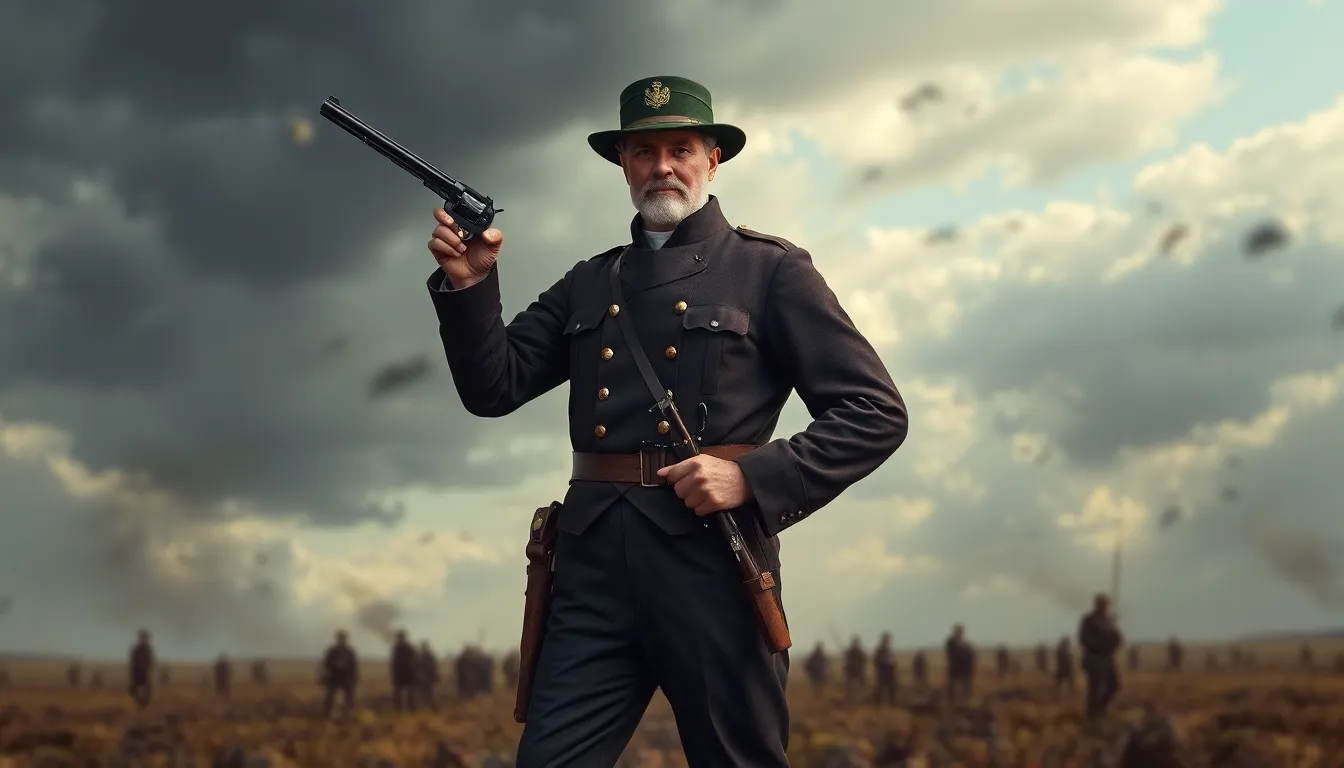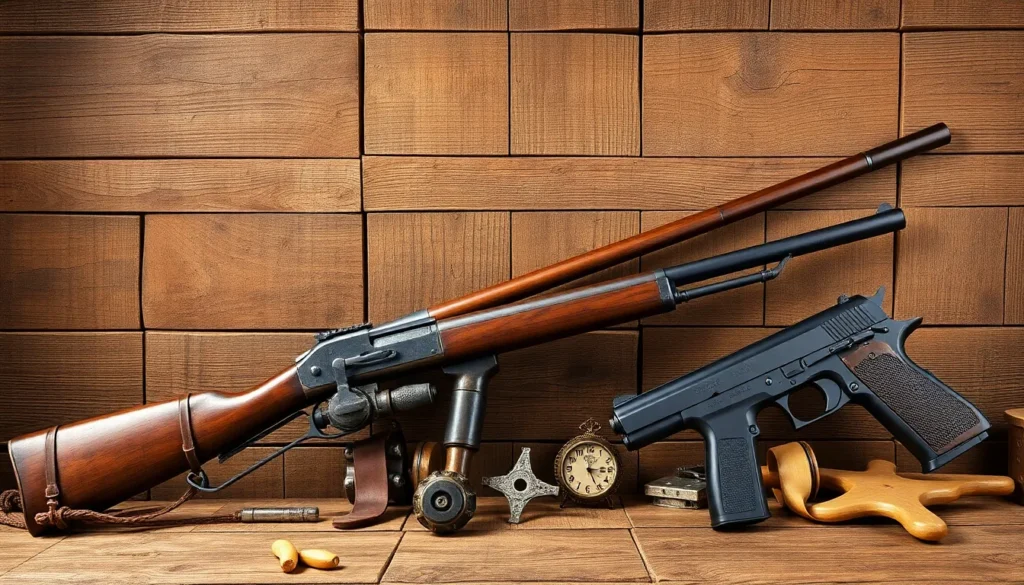Table of Contents
ToggleGuns have shaped history in ways that are both fascinating and a bit terrifying. From the moment someone decided that throwing rocks just wasn’t cutting it, the quest for a more effective weapon began. But when exactly did this pivotal invention make its debut? If you think it’s just a tale of powder and projectiles, think again.
Overview of Gun Invention
The invention of the gun dates back to the 9th century. Chinese alchemists developed gunpowder, which played a crucial role in creating early firearms. Early records show that the first guns, such as fire lances, appeared by the 10th century. These weapons combined a tube with gunpowder and projectiles.
By the 14th century, advancements occurred with the introduction of hand cannons. These devices used a simple matchlock system to ignite gunpowder. The technology rapidly spread across Europe, sparking interest in firearms among various nations.
The 15th century marked a significant leap in gun design. It introduced the wheellock mechanism, allowing a more reliable firing method. This advancement paved the way for the development of more sophisticated firearms in the following centuries.
During the 17th century, the flintlock became popular due to its ease of use. This design featured a striking mechanism that made ignition quicker and more dependable. Many armies adopted flintlock rifles, changing warfare strategies across Europe and beyond.
The 19th century saw the emergence of revolvers and repeating rifles. Innovations like the Colt revolver revolutionized personal firearms. These new designs enhanced firepower, contributing to significant historical events, such as the American Civil War.
Throughout history, the evolution of guns reflects technological progress. Changes in materials and manufacturing processes cultivated remarkable improvements. The ongoing development of firearms continues to shape military tactics and personal defense.
Historical Context

Guns have a rich history that greatly affected societies across the globe. Understanding this historical landscape reveals key developments in weaponry and their impact on warfare.
Early Weaponry Development
Firearms evolved significantly from early weaponry. The emergence of gunpowder in the 9th century by Chinese alchemists set the stage. Fire lances became one of the first firearm types in the 10th century, combining flame projection with metal projectiles. Following this, advancements included hand cannons in the 14th century, distinguished by their primitive firing mechanisms. The introduction of matchlock systems simplified loading and firing processes, allowing for greater accuracy. By the 15th century, the wheellock mechanism improved reliability and usability. These innovations marked a transformation in the development of firearms, leading to more sophisticated designs that shaped future conflicts.
Influence of Warfare
Warfare strategies transformed due to advancements in firearms. The flintlock design, popularized in the 17th century, provided soldiers with faster firing capabilities. This shift significantly affected battlefield tactics, introducing new methods of engagement. The 19th century brought revolvers and repeating rifles, like the Colt revolver. These innovations allowed for sustained fire during critical moments in conflicts such as the American Civil War. Consequently, military engagements became more lethal and efficient. Overall, the introduction of firearms changed not only weaponry but also the nature of warfare itself, leading to new approaches in combat.
The First Known Firearms
The early evolution of firearms reveals significant advancements. Among those early innovations, the hand cannon stands out.
The Hand Cannon
The hand cannon emerged in the 14th century as one of the earliest forms of portable firearms. Builders crafted these weapons from metal tubes that housed gunpowder and projectiles. They ignited the powder using a burning wick, creating a simple yet effective firing mechanism. Different cultures utilized these hand cannons, often featuring varied designs and sizes. The use of gunpowder marked a pivotal shift in warfare, providing soldiers with a powerful tool that changed combat dynamics.
The Matchlock Mechanism
The introduction of the matchlock mechanism in the 15th century transformed firearm operation. This innovation incorporated a match cord that ignited gunpowder when triggered. Shooters could now aim and fire more accurately, enhancing battlefield effectiveness. The matchlock design initially appeared in Europe but quickly spread globally, influencing firearm development. Its reliability improved shooting techniques, ensuring greater consistency during use. Consequently, military tactics evolved, leading to more organized and strategic forms of combat.
Advancements in Gun Technology
Significant developments throughout history transformed firearms, enhancing their efficiency and effectiveness in combat situations.
The Flintlock Era
The flintlock mechanism emerged in the 17th century, revolutionizing firearm design. Innovative in nature, this system utilized a flint striking a steel frizzen to ignite gunpowder. Enhanced firing speed became possible with this design, leading to a more dynamic battlefield. Military units began adopting flintlocks, resulting in improved organization and effectiveness during engagements. Customized flintlocks also gained popularity among marksmen, indicating dual usage for both military and civilian purposes. This era marked a pivotal shift toward more efficient and reliable firearms.
Innovations in the 19th Century
The 19th century ushered in groundbreaking advancements in gun technology. Revolvers became prominent, offering multiple shots without reloading. Notably, the Colt revolver set a standard in firearm design, widely used during and after the American Civil War. Repeating rifles also gained traction, allowing for quicker successive shots and effective long-range engagements. The introduction of breech-loading mechanisms marked another significant milestone, minimizing loading times and inefficiencies. These innovations not only shaped weapon functionality but also had lasting impacts on military tactics and civilian use.
The Evolution of Guns in Modern Times
The evolution of guns continues to influence warfare and personal security. Firearms have transformed significantly, particularly during the 20th century.
The Impact of World Wars
World War I and World War II accelerated firearm development. Innovations arose from the need for rapid advancements to meet battlefield demands. The introduction of automatic weapons during World War I, such as the machine gun, changed combat strategies. Soldiers utilized these firearms for suppressive fire, altering tactics and formations. World War II saw the emergence of submachine guns, offering portable power in close combat. Iconic examples include the Thompson and the MP40. Each advancement during these conflicts highlighted the importance of adaptability in weaponry.
Contemporary Firearm Design
Contemporary firearm design emphasizes versatility, safety, and user experience. Manufacturers focus on lightweight materials and ergonomic designs to enhance usability. Innovations such as polymer frames have led to a rise in the popularity of handguns. Advances in technology contribute to features like integrated optics, ensuring improved accuracy. Furthermore, modular systems allow customization according to user preferences. Regulations have evolved, creating a landscape where both civilian and military firearms undergo strict scrutiny for safety and efficacy. Overall, modern firearms reflect a commitment to technological advancements and user needs.
The journey of guns from their early origins to modern innovations illustrates a profound transformation in both technology and society. Each advancement has not only altered the dynamics of warfare but also influenced personal security and civilian life. As firearms continue to evolve, their impact on tactics and user experience remains significant. Understanding this history is crucial for appreciating the complexities surrounding firearms today. The ongoing development reflects a balance between innovation and responsibility, shaping the future of how guns are perceived and utilized.







